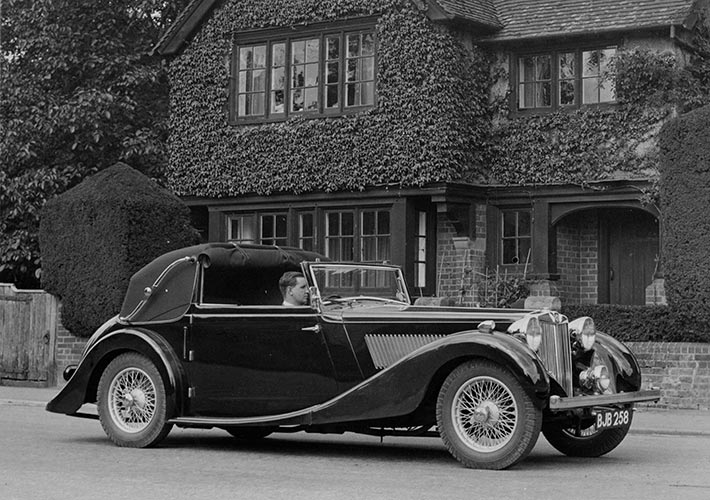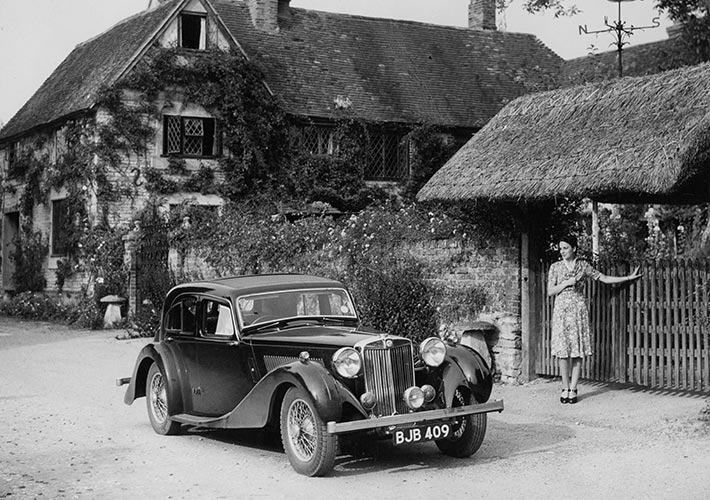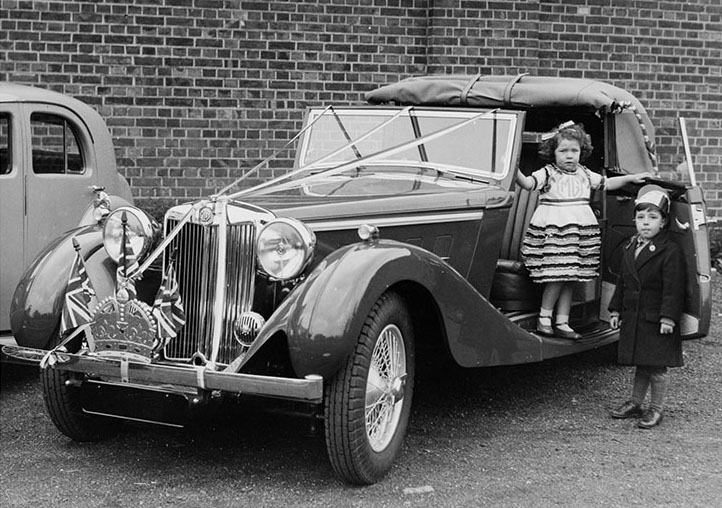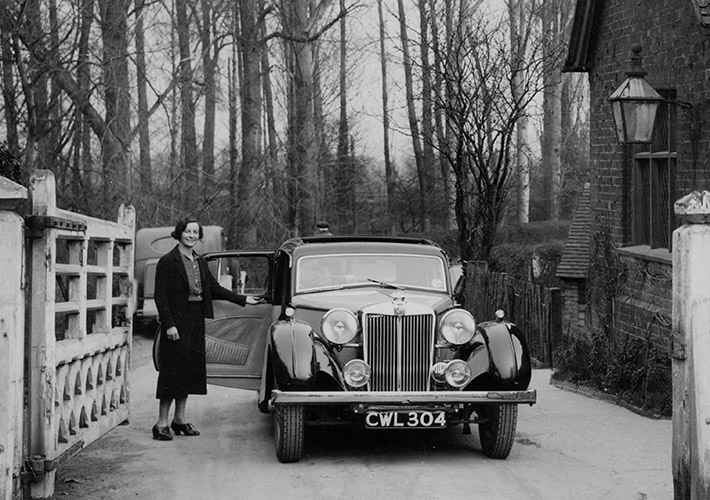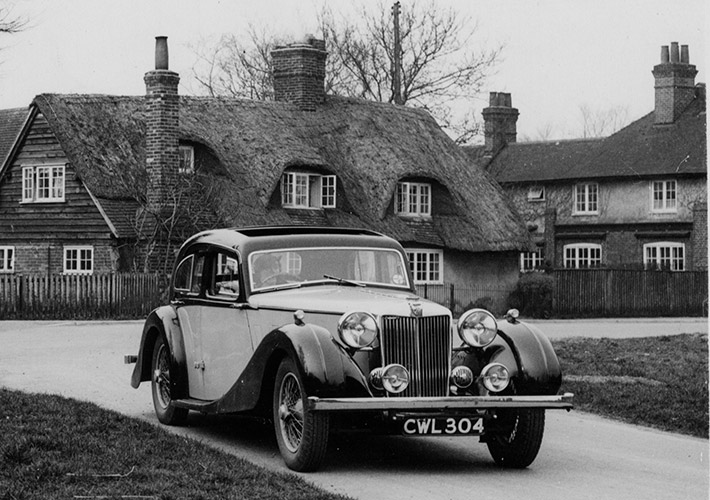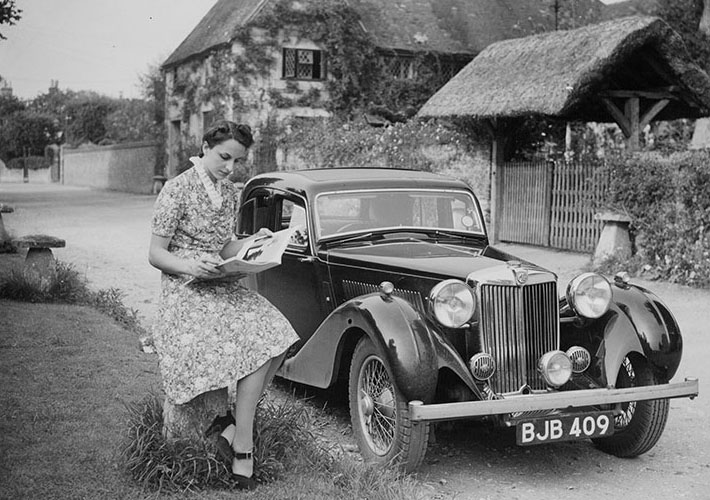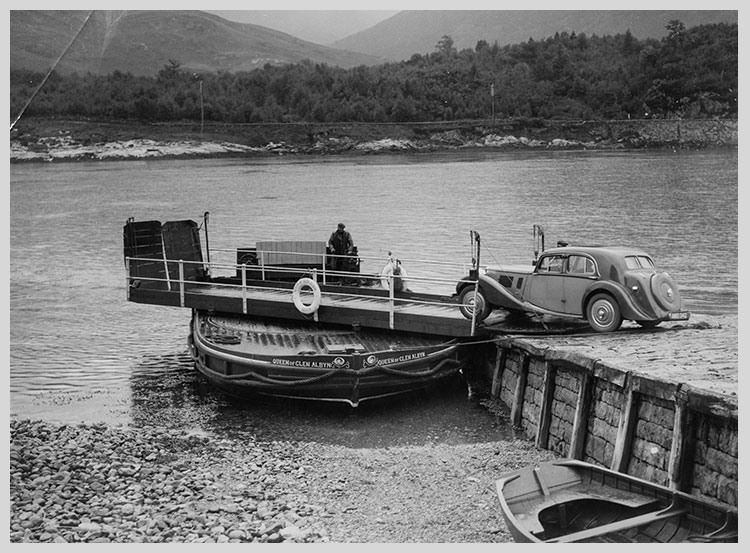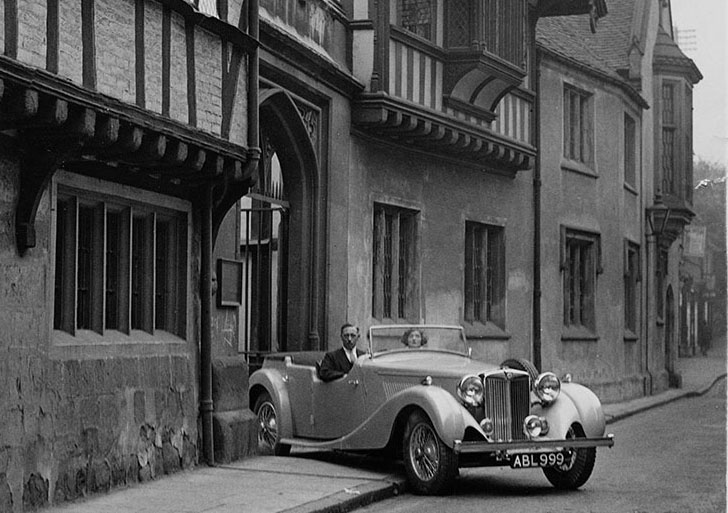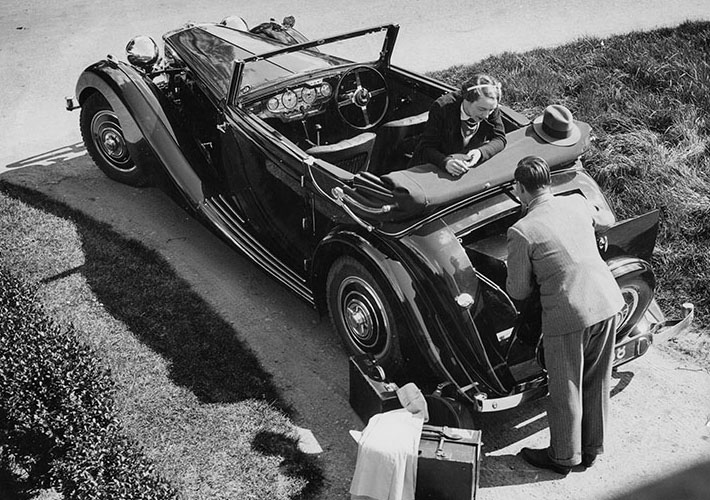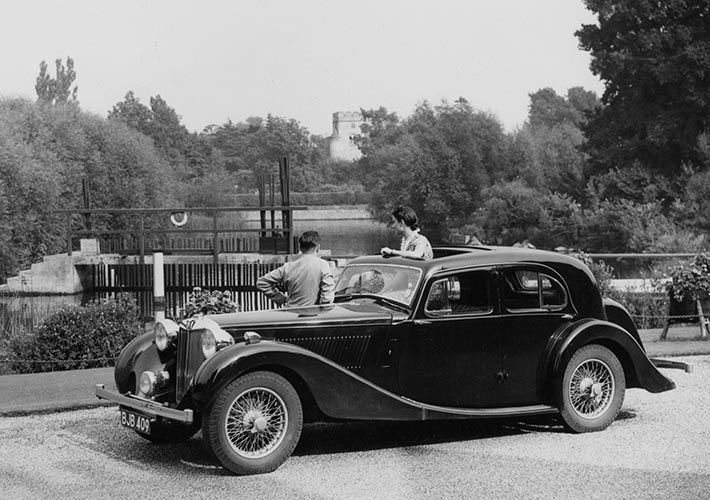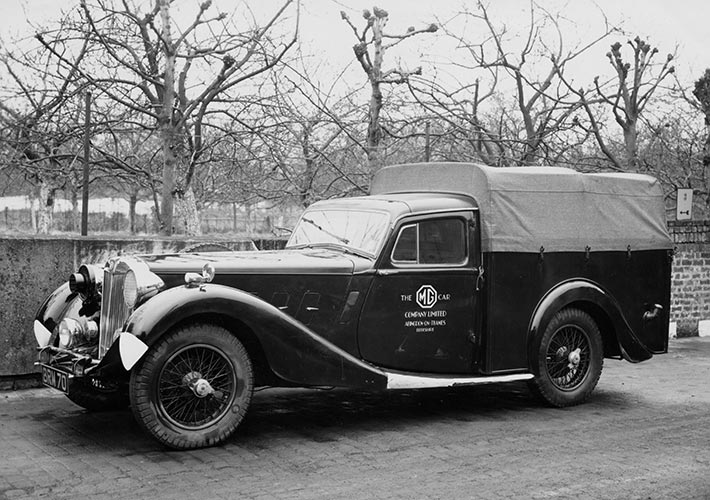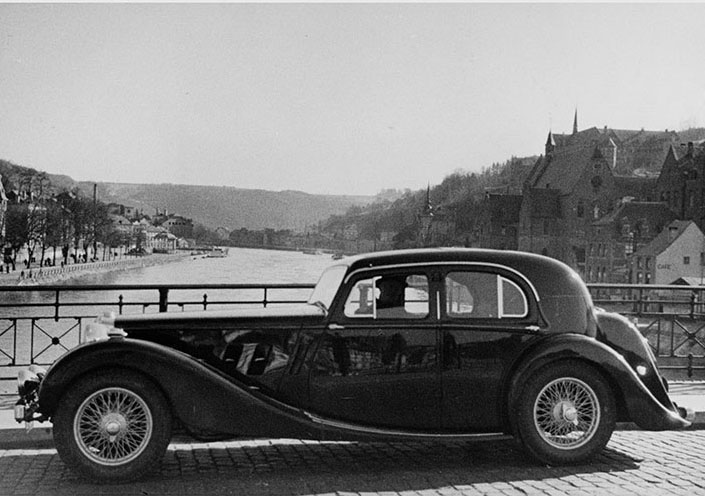The SA Sports Saloon was the first of the cars in the MG “SVW” family incorporating the SA (2 litre), VA (1.5 litre) and WA (2.6 litre) models manufactured from October 1935 to late 1939.
Although the SA was not the first saloon that MG had produced, it was considered by many to be the finest looking. It was the largest MG model, eclipsed only by the 2.6 litre WA in 1938 and nothing MG has produced since has come close. The saloon was one of the standard models offered and intially cost £375. Also offered was a 2 door convertible with coachwork by Salmons & Sons, known as the Tickford, and a 2 door convertible with coachwork by Charlesworth, known as the Tourer. The Tickford initially cost £398 and the Tourer £375. Although known for his legendary pursuits in creating, building and publicising MG sports cars, Cecil Kimber left behind his legacy in commissioning from Mulliner the design of the stunning saloon.
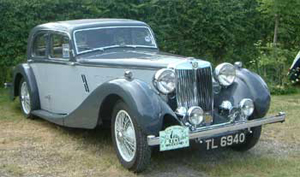
SA Saloon
Due to the availability of materials, craftsmen and traditional manufacturing techniques, the cars were still largely hand built (in a production line) by coachbuilders using a timber ash frames and metal panels nailed onto this frame. MG produced the rolling chassis, with the body to be completed by the coachbuilder (Morris Motors)
The SA was marketed as the “Two Litre”. However after the SA was announced at the October 1935 Motor Show, and before the SA was available at the dealer network, the factory increased the engine size to 2.3 litres to give the car better performance in a competitive market.
See the SA Gallery for some original MG factory photos of SA cars.
A model of its era
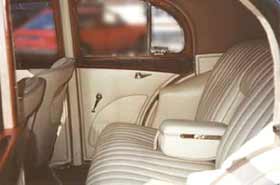
SA Interior
The SA was a model of its era, displaying the finest of coachwork and the most luxurious interior. The intricate inlaid woodwork, the art-deco silk cushions, arm rests, the full leather interior and even a rear blind was all testament to its status as a luxury model. The sunroof was de riguer in saloons at the time, so much so that the advertising at the time omitted this fact as it was expected as standard in a fine saloon. The advertising also mentions to buy a car made in the UK, and there is a suggestion that the intricate woodwork, detailed & panelled leatherwork, art silk cushions, fine embroidery was MG’s way of denoting the quality of their product.
Standard components in luxury cars of the time were the “Jackall” jacking system with independent jacks at each wheel. The front or the rear of the car could be raised off of the ground to assist in changing the wheel. This was a frequent event at the time due to the poor quality of roads. If required the whole car could be raised by using the control located under a hatch in the floor of the passenger footwell. Another feature was the inbuilt trafficators located in the pillars of the doors, which would rise in a horizontal fashion and were illuminated for use in the dark. Cigarettes were very fashionable at the time, and there were several ashtrays (all finished in bakerlite and chrome) neatly built in the interior. The original show car included lavish trumpet warning horns, however probably due to cost, these were only offered as an optional extra on production cars. For these trumpet horns there were two options available to the driver with the loud tone “for country use” and the soft tone “for town use”. One of the cross-over examples of standard saloon compared to chauffer driven saloon was remote control rear blind which would be raised and lowered by the driver via an inbuilt cable system.
“Capacious”…
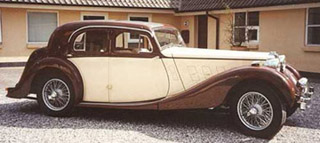
SA Saloon
The car is generous in proportion, a design feature to give the sweeping curves perspective and balance. From end to end, the overall dimension of the car was 16’1″ (approx 4.9 metres) and was therefore a very large car. The interior was spacious for driver and passengers, although no self respecting owner would have let the chauffer have all the fun. In fact the marketing department coined a new term “capacious” to describe the overall capacity and space. The styling also ensured the model had a large boot, and the spare tyre was positioned in a tyre well in the boot lid, with a separate wheel cover.
The SA model was a product of a corporate reorganisation. In the 1930s, William Morris’ company “MG” (Morris Garages at Oxford) and his publically listed company, Morris Motors, were merged into the “Nuffield Group”. The name was taken from Lord Nuffield’s peerage (on the knighthood of William Morris). Morris Motors had taken over the design and decision making away from MG and centralised planning had decreed that the 2 door sports car market, that MG had made its name as an innovator and engineer, was too costly to pursue in limited volumes. It decided that MG should be brought into line with the common components of the Morris Motor Company. One tradition not lost was the unique MG badging of everything from the diecast door handles to the dip stick so as to prominently display the MG heritage.
Performance
The power plant in the SA was the 6 cylinder Morris pushrod engine. Not quite the performance or the technology of the MG’s overhead cam 6 cylinder engines of earlier models. Economies of scale were important so it was decreed that the engine should come from the Morris Engine Plant. What the Morris engine lacked in sophistication, it made up in reliability, serviceability and volume. It was especially important to ensure the 3,325lb (approx 1.5 Metric Tonnes) car could be driven for enjoyment and not requiring regularly fine tuning. The engine was originally announced as being 2062cc, but prior to the launch in 1936 the engine capacity was increased to 2228cc and then again to 2322cc to compete with the Jaguar. Jaguar had taken advantage of the inefficiencies of the central planning of the Nuffield group by getting their car to market way ahead of MG. The horsepower tax in those days also dictated to some extent the size of an engine and hence the divergence of smaller more refined cars in the UK, compared to the bigger cars produced over the Atlantic. At the time the UK used a different calculation to other countries to establish the horse power. The SA was initally launched as a 16 h.p. with the increase to 2322cc making the car now 18 h.p.
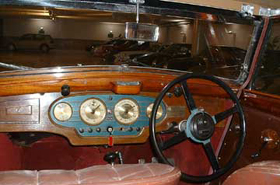
SA Tickford dashboard
On the road the SA was then, as now, capable of cruising at 80 miles per hour. The sports car reflected the sporting heritage of the MG Car Company, and appealed to those buyers at the time who were after something better than a standard car, and yet not outrageously priced. The sports design of the car included 18″ wire wheels, knock-on hubs, long nose bonnet, and the glorious instrument panel. This panel contained a very well balanced line of instruments comprised of the speedo, rev counter, water temperature, amps, 8 day wind up clock and a fuel gauge all finished in spectacular pale gold trim. Also there was a lovely touch of refinement with a switchable petrol and oil gauge.
Production
The production of the SAs ceased with the outbreak of hostilities of World War II in 1939 and signified the end of an era. Although a relatively short production life in modern day manufacturing, the SA had made its mark. Indeed it was rare for any previous MG model to last for longer than a year in production due to the small scale of production runs, continual development and technical innovation. The next ‘big car’ was not released until 1949 (the Y type), although this was a compromise of availability of materials and restricted engine size due to post war rationing.
The SA was considered by many purists to not be a ‘proper’ MG, however the overall sales figures show that these large SVW cars were more popular than the smaller T type. There were only 3382 TAs and TBs produced in the same period as the 5514 SVWs, which supported Kimber’s faith in producing a larger, more elegant car.
Details of production are listed below (note there are discrepancies in the exact figures for some reason, but this is what the MG factory records show):
SA Production by Year
| Year | No. of SA Cars produced |
|---|---|
| 1935 | 2 |
| 1936 | 1,118 |
| 1937 | 966 |
| 1938 | 524 |
| 1939 | 128 |
| Total | 2,738 |
SA Production by Body type
| Body type | No. of SA Cars produced |
|---|---|
| Saloon | 1,945 |
| Drop Head Coupe | 696 |
| Tourer | 90 |
| Chassis | 14 |
| Total | 2,745 |
SA Production Markets (all body types)
| Country | No. of SA Cars produced |
|---|---|
| Home Market | |
| UK | 2,396 |
| Export Market | |
| Germany | 71 |
| India | 41 |
| Malaya (Malaysia) | 30 |
| Belgium | 30 |
| Sweden | 29 |
| Australia | 23 |
| Switzerland | 18 |
| Holland | 16 |
| South Africa | 13 |
| Argentina | 10 |
| New Zealand | 7 |
| Portugal | 6 |
| Ceylon (Sri Lanka) | 6 |
| Guernsey | 5 |
| Jersey | 5 |
| Austria | 4 |
| Eire (Ireland) | 4 |
| Egypt | 3 |
| Other countries (less than 3) | 28 |
| Total | 2,745 |
Source: MG Factory production records held by the SVW Register, “MG Saloon Cars” by Anders Ditlev Clausager and “MG by McComb” by F Wilson McComb.
SA gallery
Below are some of the original MG factory photos of SAs.

